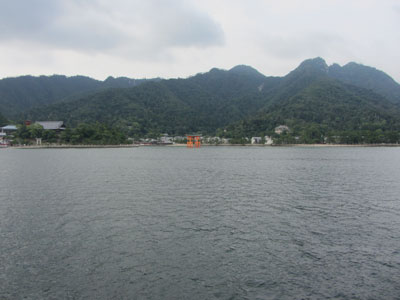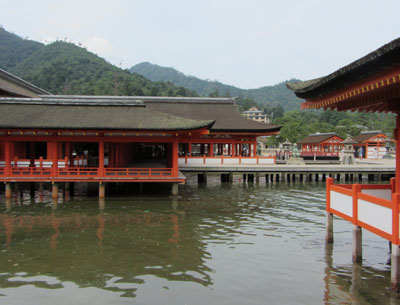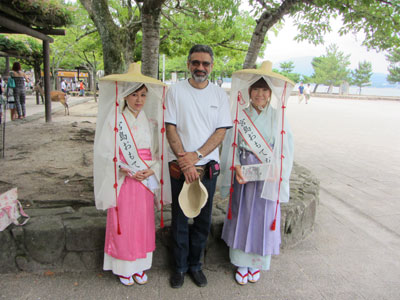Hiroshima Travelogue- Episode 9
August 5, 2013
We are taken to another beach the next morning to visit another isle. There are vessels to carry only human passengers from the beach to the isle. The vessels which were used for going to the Econojima isle could carry cars as well. The vessel breaks through the beautiful water to the isle. The green heights of the isle can be seen from the vessel. A little further, a religious sign can be seen in the water near the isle.

We arrive in Miyajima Island. The tangible serenity of the area embraces us all upon our arrival. Here are no stuff brokers with their annoying bullhorns nor are one-stroke engines whose exhausts are tampered with. Astonished enough with the scenery, we see a little further a herd of absolutely tamed deer standing or sitting around.


I move forward to one of the deer and take a picture with it. There are more religious signs on the way; dragon-like taps, the gateway of gods, and a great temple with its wooden pillars all stationed in the water. The isle is said to be among world heritage and its religious background dates back to over 1,200 years ago when a Buddhist priest came to Miyajima in search of light and stayed in one of the mounts in the region. Just like other religious structures that I have so far seen in Japan, here is a tourist attraction as well. The island’s economy depends on the shops placed in a market about the temples rather than the temples themselves.
As we pass through the shops, we hand over some of our exchanged dollars to the shopkeepers. Upon my return, I can’t help stopping by and taking a picture with two female guides who wear local garments.

Free in the afternoon, we get out of our one-bed rooms and walk about to see Hiroshima. It’s a newly-built city. After the atomic disaster, only one building has been kept intact as a symbol of the incident and the rest of the city is renewed, as it should.
I see neither garbage nor garbage bins in the streets. “Such a great idea for not producing garbage,†I think. You cannot smoke in the city except before special stores or some parks where ashtrays are installed.
A considerable number of individuals ride bicycles in specially designed ways in pedestrians. Some also move about in streetcars. Some of the streetcars are dated and belong to the time when the bombs fell on the city. They have kept them to restore to life the memory of the incident.
There are so many cars, but none stop I the streets except very shortly or out of necessity. The traffic lights are respected like they are divine. The pedestrians are revered the same.
Every driver seems to believe wholeheartedly in the priority of walkers. All pedestrians and traffic lights for the visually handicapped are specially designed to suit them. The way of cars is well-defined. No one is allowed to change lines. Every line has a specific light. A line can happen to be filled with cars while its adjacent line is free for the cars to rush along.
One envies the citizen’s tranquility.
Hedayatollah Behboudi
Translated by Abbas Hajihashemi
Number of Visits: 4949








The latest
Memoirs of Hujjat al-Islam Reza Motalebi
Hujjat al-Islam Reza Motalebi is a cleric from Isfahan. Before the revolution, he was the imam of the Fallah Mosque – which was later renamed Abuzar Mosque. By his presence and efforts, Abuzar Mosque soon became a base for supporters of the Imam and the revolution. After the victory of the revolution, he played a role in uniting forces and maintaining political vitality in southwest Tehran.The Necessity of Receiving Feedback in Oral History
Whenever we engage in a task, we naturally seek ways to evaluate our performance — to correct shortcomings and enhance strengths. Such refinement is only possible through the feedback we receive from others. Consider, for instance, a basketball player whose shots are consistently accurate; should he begin shooting blindfolded, his success rate would rapidly decline, as he would be deprived of essential feedback from each attempt.Sir Saeed
The book “Sir Saeed” is a documentary [narrative] of the life of martyr Seyyed Mohammad Saeed Jafari, written by Mohammad Mehdi Hemmati and published by Rahiyar Publications. In March 2024, this book was recognized as one of the selected documentary biographies in the 21st edition of the Sacred Defense Book of the Year Award. The following text is a review on the mentioned book.Morteza Tavakoli Narrates Student Activities
I am from Isfahan, born in 1336 (1957). I entered Mashhad University with a bag of fiery feelings and a desire for rights and freedom. Less than three months into the academic year, I was arrested in Azar 1355 (November 1976), or perhaps in 1354 (1975). I was detained for about 35 days. The reason for my arrest was that we gathered like-minded students in the Faculty of Literature on 16th of Azar ...

